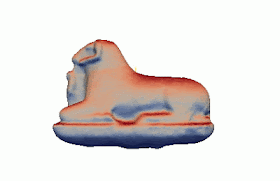Hi all,
this post reports some technical informations regarding Cicero's article about Converting pictures into a 3D mesh with PPT, MeshLab and Blender.
The experiment to digitally document in 3D a statue of the Egyptian Museum in Torino (IT) was aimed to hardly test the potentialities of SfM techniques in archaeology.
The idea just came when I was visiting the exposition with my wife Kathi, during an holiday: I asked the guardians if it was possible to take photos and they answerd me that there were no problems as long as I was not using the flash.
As you can see from the picture below, I found a perfect situation when I reached the first statue's room; the athmosphere was charming, while the sculptures were in darkness, with only a spot light to make them stand out.
 |
| Spot light condition |
This particular light condition was a good test for SfM techniques because I could not modify it "artificially" (e.g. with other lamps to get a better illumination of my subject). Moreover I could not use the flash, so I had to turn the ISO of my Nikon D70 to the maximum value, in order to be able to take pictures without the help of a tripod.
Another difficulty arose from the necessity to acquire the data quickly, without disturbing the visit of the other tourists.
 |
| The croweded room |
Anyway, having increased the ISO of the camera, it was not a problem to collect all the data in just a couple of minutes.
Once home, I tried to do a 3D digital model with SfM and IBM techniques, using Pierre Moulon's PPT. Since I did not think to succeed in my purpose, I did just a fast 3D model, with low quality parameters (scaling all the pictures on a medium resolution). Contrary to what I thougth the model was accurate enought and the experimentation went on thanks to the collaboration of Cicero Moraes, who was able to recreate an high quality texture, using the methodology he described in his post.
 |
| The 3D low quality model in Paraview |
CREDITS:
This article was possible thanks to the kindness of Dott.ssa Paola Matossi L'Orsa and Dott.ssa Sara Caramello and with the permission from the "Fondazione Museo delle Antichità Egizie di Torino".
Thanks for mention low light conditions. I also noticed difficulties using osm-bundler to reconstruction architecture features, with photos taken just before twilight. Photos perfectly clear for human eye but not for osm-bundler.
ReplyDeleteI didn't exactly understand how do you converted you photos so they could work with osm-bundler (size? resolution? other processes?).
Moving objects, like people or cars, aren't a problem to bundler algorithm, because it ignores them, unless they continue to appear, static, after a predefined number of pictures (http://phototour.cs.washington.edu/bundler/).
rgaidao
Hi Ricardo,
ReplyDelete1) I did not convert the photos, they worked good with PPT without any "postprocessing". Normally when we work with low-light condition (e.g. an excavation in a church), we simply use a tripod for the camera and this is enought. In Torino I could not (I had no tripod and there was too few time for data acquisition), so I simply turned to the maximum value the ISO (sensibility to light) of my camera (http://en.wikipedia.org/wiki/Film_speed). In this way I could take clear "free-hand" pictures also in the darkness (obviously the flash was a better option, but inside the museum was forbidden...).
2) Yes, moving objects are not a problem for PPT,but in that occasion they were a problem for me, because had to collect all the pictures very quickly, without disturbing the othe turists. That's one of the reason I think this test was good to evaluate SfM and IBM techniques in difficoult conditions. We did other test like this one (documentation from the sky, underwater, etc...). Soon we will post the results in ATOR
Ciao!
Thanks. I finally understood. The goal was to prove the possibility of using high iso photos (lots of noise) with PPT.
ReplyDeletergaidao